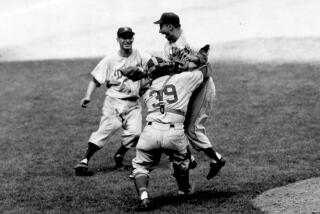In this game, it’s hard to stop once you get rolling
- Share via
Some 21-year-olds like to play “MLB ‘08: The Show,” while others prefer “MLB 2K8.” I play APBA Baseball.
The first two are video games. APBA Baseball is played with dice. On a cardboard baseball diamond. It first became popular in the 1950s -- before PlayStation, before fantasy leagues -- and the company that created it is still in business, updating the game each year.
In APBA, every major league player has his own card, and before you play, you get to act as manager, choosing the lineup and your pitcher. After that, your success is mostly a product of luck.
One of the charms of APBA is the uncertainty of each game. It’s not a video game in which you can master the timing of your swing and pretty much win every game. That gets old quickly. In APBA (pronounced “APP-bah”), each roll is distinct and brings with it the suspense of watching a real baseball game.
But its ultimate appeal, for me at least, has little to do with the actual game.
My father, Chet, grew up with this game, and held onto it as others his age got rid of it. Then he taught it to my younger brother, Matt, and me. I’m glad he did. For the rest of my life I’ll take with me the countless hours we have spent playing it in our home near Scranton, Pa.
Sure, the game has its flaws. It’s up to you to keep it as realistic as possible because pitchers are merely names on a card -- they never get tired -- and injuries are few and far between. But the game allows you to pit some of the greatest teams of all time against one another, and make some memories along the way. Among many others, we’ve played games between the 1927 Yankees and 1998 Yankees, and replayed some classic World Series, like 1952, when the Yankees beat the Dodgers in seven. (We’re Yankees fans, sue us.)
Then Dad undertook the task of playing the 1961 season. That’s right, he played an entire season, with our help, of course. (Luckily, Dad is a teacher, so his summers are relatively free.) One of us spent a portion of each day playing a few games.
It took us nearly three years, but every American League team played 162 games, each National League team played 154 and we kept a box score for each game. For the most part, the results were realistic. Roger Maris ended up hitting 65 home runs. Take that, Ford Frick. Mickey Mantle hit 56, when he actually hit 54. The Yankees won the AL. The Dodgers won the NL by one game over the Reds. In real-life 1961, the Yankees did win the AL on their way to beating Cincinnati in the World Series while the Dodgers finished four games behind the Reds.
The stage was set for our World Series showdown. Matt took the Dodgers, I took the Yankees and Dad kept the stats. Matt, now 12, shocked us all by taking the first two games of the Series, but thanks to a six-home run performance in Game 4, two apiece from Mantle and Maris, I turned the tide. The Yankees won in six.
However, there were a few aberrations in our season; chief among them was Norm Cash’s batting average. The Detroit first baseman hit .418 for us, 57 points higher than his actual batting average.
For Dad, the 1961 season was magical. He was 12 when he saw his idol, Mantle, and Maris chase Babe Ruth’s home run record. Playing APBA is a flash to the past for him, a way to remember the summer days he spent playing baseball with his friends on the block, before watching the games on TV or listening to them on the radio. APBA allows Matt and me to become acquainted with baseball’s rich past. We know more about baseball history through playing the game than is probably healthy for kids our age.
I spend most of my days away from home now, but that hasn’t stopped Dad from undertaking another series with Matt. This time, it’s 1956.
“I think 1956 will be more realistic,” Dad says.
We’ll see about that. But even if it isn’t, it’s still going to be fun.
--
More to Read
Go beyond the scoreboard
Get the latest on L.A.'s teams in the daily Sports Report newsletter.
You may occasionally receive promotional content from the Los Angeles Times.










